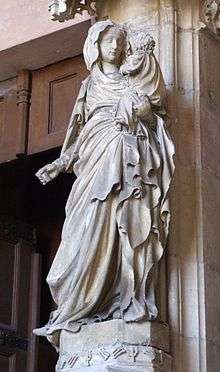Jean de Marville
| Jean de Marville | |
|---|---|
| Born | Marville, Burgundy |
| Died | July 1389 |
| Nationality | Burgundian |
| Occupation | Sculptor |
| Known for | Sculpture in the Carthusian monastery of Champmol at Dijon |
Jean de Marville (died July 1389) was a sculptor who worked at the end of the fourteenth century. He is known for his work on the Carthusian monastery of Champmol for Philip the Bold, Duke of Burgandy at a time when the Burgundy became a major cultural center of Europe.

Origins
From his name it appears that Jean de Marville originated in Marville in what is now the department of Meuse, in northern France. At that time Marville was in Burgundy. Some say that he was Flemish. He is also known by the names Hennequin or Hannequin de Marvile, Jan van Mergem, Jehan de Marville or de Mervile.
Career
The Jean or Hennequin de Marville who worked on the tomb of Philip the Bold has been identified with the Jean de Menreville who was named in 1366 as working on the church of Saint-Pierre at Lille.[1] He is named as working in Rouen Cathedral in 1369, where he helped decorate the chapel of the king's heart at the command of King Charles V of France. He joined the service of Philip the Bold on 22 January 1372 as ymagier et valet de chambre de Monseigneur.[lower-alpha 1][2] The next year he moved to Dijon on the command of the Duke.[1] An account from 27 January 1377 records the purchase of 26 pounds of ivory for Mainreville, tailleur de menues oeuvres. Based on this an ivory figure of the Trinity in the Museum of Fine Arts, Houston may be attributed to him.[2]
Jean de Marville created an important school of sculpture. Claus Sluter was the most noted member.[3] Sluter's nephew Claus de Werve was another member of this school.[4] Lesser sculptors of this school were Jehan de la Huerta and Antoine le Moiturier.[5] Claus Sluter (c. 1360 - 1405), a sculptor from Harlem in the Netherlands, joined Jean de Marville's studio in 1383. At that time de Marville was directing the construction and decoration of the Chartreuse of Champanol, which was to be the Duke's burial place.[6] The image of the virgin and child in the center pillar of the monastery's chapel is attributed to either Marville or Sluter.
On 29 March 1381 Marville was charged by the Duke with making an alabaster sepulcher for him in Dijon, and the work was started in October 1384.[7] Sluter succeeded Jean de Marville as ymagier when he died in 1389.[6] There seems little doubt that the bulk of the work was done by Sluter, or under Sluter's direction, since it was not completed until 1404.[lower-alpha 2][8] The tomb is unusual in being decorated with free-standing statues of monks, clergy and laity rather than the conventional relief figures. This concept may have been Marville's, but could have been a change introduced by Sluter when he took charge of completing the project.[9]
Notes and references
Notes
Citations
- 1 2 Cornereau 1890, p. xvi.
- 1 2 Baudoin 1996, p. 107.
- ↑ Chabeuf 1891, p. 11.
- 1 2 Société de l'Ecole des chartes 1884, p. 302.
- ↑ Chabeuf 1891, p. 70.
- 1 2 Vauchez, Dobson & Lapidge 2000, p. 1364.
- ↑ Baudoin 1996, p. 108.
- ↑ Chabeuf 1891, p. 104.
- ↑ Woods 2007.
Sources
- Baudoin, Jacques (1996). "Jean de Marville". Bourgogne, Franche-Comté. EDITIONS CREER. ISBN 978-2-909797-17-5. Retrieved 2013-01-09.
- Chabeuf, Henri (1891). Jean de La Huerta: Antoine Le Moiturier et le Tombeau de Jean sans Peur. imp. Darantière. p. 11. Retrieved 2013-01-09.
- Cornereau, Armand (1890). Mémoires de la Société bourguignonne de géographie et d'histoire. Retrieved 2013-01-09.
- Société de l'Ecole des chartes (1884). Bibliothèque de l'École des chartes. Decourchant. Retrieved 2013-01-09.
- Vauchez, André; Dobson, Richard Barrie; Lapidge, Michael (2000). Encyclopedia of the Middle Ages. Cerf. ISBN 978-1-57958-282-1. Retrieved 2013-01-09.
- Woods, Kim (2007). Making Renaissance Art. Yale University Press. p. 110. ISBN 978-0-300-12189-6. Retrieved 2013-01-09.